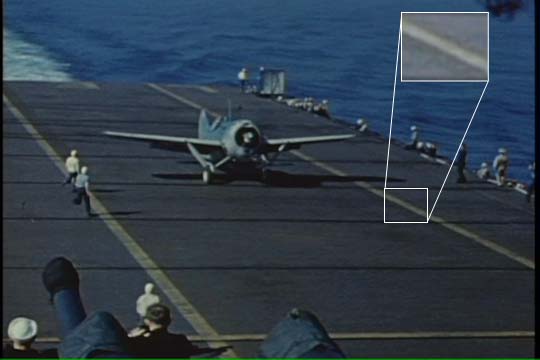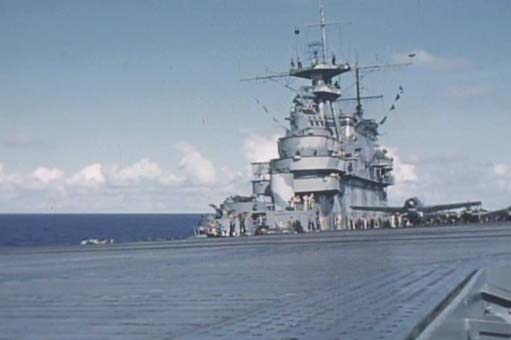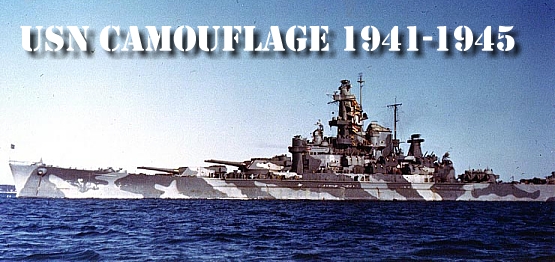

|
Adoption of Blue Flight Deck Stain on US Navy carriers
(Thanks to Michael Vorrasi for this piece)
It has long been the subject of conjecture and speculation among naval enthusiasts and ship modelers as to just when
US Navy aircraft carriers adopted Blue Flight Deck stains. Uninformed sources will often say something like early 1942,
or some such. Many modelers and artists continue to erroneously depict USN WW2 carriers with brown decks despite
numerous examples of contrary evidence. Color shifted photos have also long been a source of problems causing lots of confusion as well. It has long been my contention that all USN carriers wore blue deck stain well prior to Pearl Harbor. Supporting my position has been Dick Best, of Midway fame, who stated in a video taped interview that all US carriers were in blue deck stain prior to the start of WW2. He was rather empathetic on this point, as he was commenting on the surprise shared by US aviators at seeing bright yellow stained decks with big red honomarus on the Japanese carriers they dived on at Midway. Ships-2 of September 1941 leaves open the question of carrier deck color, and advises USS Ranger is conducting tests of camouflage flight deck stains. Then a data gap occurs until the next update, the June 1942 edition of Ships-2, which confirms blue flight deck stains as regulation. This gap has been partly filled by known color photo evidence of blue decks or other memorandum prior to 7 December 1941.
Additional evidence is the documented fact that Enterprise adopted blue deck stain in July, 1941, and film footage of Lexington in October, 1941 off California landing Buffalos shows a blue deck with light gray deck markings on top of her original mahogany stained deck and chrome yellow markings. If seen in B&W, the viewer would conclude she still wore pre-war mahogany stain. (Some have stated that the stripes were still yellow. I have studied blown up screen shots from this footage. The markings are clearly light gray. They are definitely not chrome yellow markings.) They are the same style as her pre-war stripes and LEX lettering. Mention is often made prior to the Ships-2 June 1942 edition, that Ranger was conducting experiments with blue stains, but no dates or other information has yet made the rounds. Now we have the hard dates and orders and who issued them.
 A new book, “USS Ranger, 1934-1946, The Navy’s First Flattop from Keel to Mast” by Robert J. Cressman, has provided the information to fill in the blanks. The book is an exhaustive biography of USS Ranger. I can only wish for a similar treatment of other great carriers like the three Yorktowns (which have all been done, but none to my satisfaction), Lexington (also partly done) and several of the more famous Essex class ships. (Saratoga has a good photographic biography available.)
The details of Ranger’s blue deck stain tests and subsequent orders to the fleet to stain flight decks in blue now seals the deal. Blue Flight Deck Stain was in place on all US carriers pre-December 1941. Ranger entered Norfolk Navy Yard on 12 July 1941 for an overhaul and upgrade of armament and radar equipment as well as a weight reduction program. During this yard period, which lasted until 17 September 1941, Ranger painted up in Measure 12 Graded and her deck was stained with Blue Deck Stain, Norfolk Formula No. L-81-3m. Photos in the book show Ranger applied the stain covering all prewar stripes and markings, although you can see shadows of their outlines under the stain.
Ranger then sailed for fleet operations in late September 1941, allowing her pilots to size up the new deck color. She dropped anchor on 2 November 1941 at Portland Maine. At that time, Ranger’s CO, Capt. Harrill responded to the request by the Commandant of the Norfolk Navy Yard for comments on the performance of the new stain. Capt. Harrill advised that the pilots had no problems lining up on the deck during operations, and noted that the carrier deck was much more difficult to see from the air compared to the mahogany stain and yellow markings previously worn. In view of its ease of application and concealment factors, he recommended its adoption on all aircraft carriers. On 17 Nov 41, Capt. Harrill elaborated further in response to the Yard’s request, advised that the single coat applied to Ranger was not wearing well, and that while it penetrated older planks well, it did not penetrate new planks as well. He recommended the yard improve the penetration performance of the stain in newer wood. (Something easily accomplished in a wood stain by increasing the mineral spirits content, basically, more thinner. The result was Norfolk No. 250N Blue Flight Deck Stain).
Meanwhile, Admiral Cook of the Atlantic Fleet, endorsing Capt. Harrill’s earlier comments, issued orders within a week (of 2 Nov 41) directing all other aircraft carriers to apply the blue stain as soon as practicable. Applying flight deck stain could be done at anchor or even at sea in calm weather, so application would have been very soon thereafter. These orders were sent to the CO’s of Wasp, Yorktown, and the escort carrier Long Island. The brand new carrier Hornet was still in the hands of Norfolk Navy Yard fitting out and conducting builders’ trials. Her omission by Admiral Cook may be indicative of the fact that Norfolk Navy Yard had already applied their new blue stain to her deck. It is inconceivable that the yard would have stained her brand new flight deck mahogany when they had just completed painting up Ranger in the same Measure 12 Graded scheme, with blue deck stain a month prior, and were in the process of adopting blue stain fleet wide, and even more inconceivable that they would let her sail on her abbreviated shakedown without blue deck stain on 27 December 1941. I say this because the pre-commissioning series of photos of Hornet in Measure 12 Graded have never struck me as having the proper B&W tonal qualities consistent with Mahogany and Yellow. Rather she appears to already be in blue stain with light gray pre-war style stripes and HNT letter markings, similar to what Lexington was already wearing in early October 1941. By the time Hornet repainted to Measure 12 Modified, in February 1942, color photos confirm a blue deck, but the November 1941 fleet orders now confirm that she would have had a blue deck well prior to sailing on her shakedown cruise.

The missing link between Ships-2 Sept 41 edition and June 42 edition regarding instructions on carrier deck stains can now be filled. Orders were issued by early November 1941 to all Atlantic Fleet carriers to apply blue stain to all carrier decks not already in blue stain. We already know that of the Pacific Fleet’s three carriers at the time, Enterprise and Lexington have been confirmed in blue decks by July and October 1941 respectively. That leaves only Saratoga unconfirmed, and I’ll take Dick Best’s word that all of our carrier decks were stained in (his words) “North Pacific Blue” well prior to Pearl Harbor as sufficient to cover Saratoga as well.
Case closed.
Michael J. Vorrasi
30 April 2005
|

 Snyder& Short Enterprises
Snyder& Short Enterprises